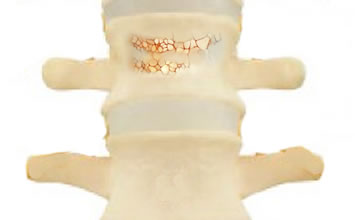A condition called osteoporosis, which causes bones to thin, can lead to spinal fractures. The kind of fracture usually resulting from osteoporosis is a compression fracture, defined as a vertebral bone that decreases at least 15 to 20 percent in height because of the fracture. This can happen to any vertebrae, but most often occurs in the upper back. NYC Spine Surgeon Dr. Fischer at NYU Langone Medical Center in New York City sees osteoporosis-related spinal fractures in patients often, as the condition occurs in nearly 700,000 Americans each year.
What is osteoporosis?
Osteoporosis is a disease that causes bones to become thinner, weaker, and more brittle. Thinning bones can collapse even during normal activities, causing significant pain and altering the shape and support of the spine. An activity may otherwise be very safe, such as opening a window or twisting while lifting or even turning over in bed, but osteoporosis patients are at a much greater risk for injury. Osteoporosis is by far the biggest cause of vertebral compression fractures. This condition has been labeled a “silent” disease, because often no symptoms are present until a fracture occurs. Even then, the fracture may not be recognized because patients believe they just have general back pain from a strain or aging.
Who is most at risk?
Osteoporosis is most common in postmenopausal women, typically over the age of 50. Studies show that about 25 percent of postmenopausal women in the U.S. have experienced spinal fractures. Even though roughly four times as many women are diagnosed with osteoporosis than men, it is still relatively common in men over 50. Hip or spine bone fractures are the most common breaks due to osteoporosis in women and men.
What are the symptoms?
Fractures of the vertebrae usually cause sudden acute back pain, often leading to chronic pain. Other common symptoms are deformity, height loss, muscle loss, limited spinal mobility, crowding of internal organs, or loss of aerobic conditioning due to the inability to maintain exercise and activities. Standing or walking worsens the pain, with some relief found by lying on the back. Multiple symptoms are usually present, negatively affecting the patient’s self-esteem and frustrations with daily living. Dr. Fischer points out, however, that sometimes spinal compression fractures do not cause pain. Experienced physicians know to look for possible fractures in middle aged or older people, especially women, if some of the other symptoms are present.
How are osteoporosis-related fractures diagnosed?
First, a full history of the patient’s current condition and medical and family histories will be taken. Then Dr. Fischer will complete a physical examination to pinpoint the cause of pain, looking for sensitivity near each vertebrae. If a fracture is suspected, an X-ray will be ordered for confirmation. Additional diagnostic tests may be required, such as a CAT scan, MRI, or nuclear bone scan. The more information the better to accurately diagnose the patient and determine the best course of treatment.
What is the treatment?
With a spinal fracture caused by osteoporosis, Dr. Fischer will usually treat both the injury and its root cause. Fracture treatment may consist of non-surgical care like rest, use of heat or ice, and pain medication. If surgery is advised, there are two minimally invasive surgeries common to osteoporosis-related spinal fractures:
- Vertebroplasty – low viscosity cement is injected into the compressed vertebrae to stabilize the fracture and relieve pain
- Kyphoplasty – a similar procedure that stabilizes the bone, relieves pain, and restores vertebral body height that was lost due to the compression fracture
After one vertebral fracture has occurred in an osteoporosis patient, the risk is great for future fractures. A key element of the treatment plan is to address the osteoporosis. This usually includes some combination of taking calcium supplements, increasing vitamin D consumption, performing weight bearing exercises, or pursuing hormone replacement therapy in women. Taking these precautions may help patients avoid future pain and immobility due to spinal fractures, allowing them to live their lives more fully.
Contact Dr. Fischer today to schedule an appointment.

